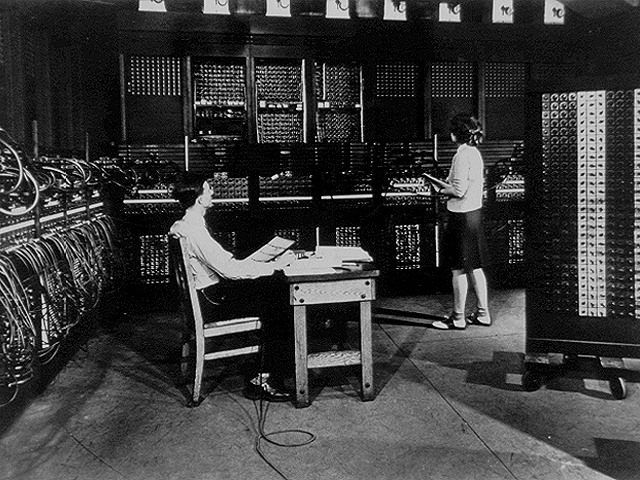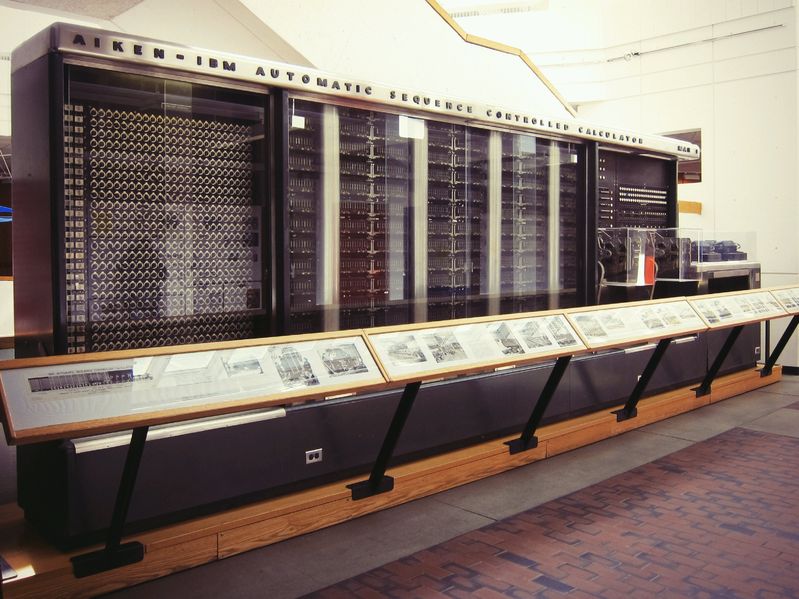The world’s first ever digital computer, ENIAC, developed by the USA in 1946, was a huge sprawl of valves and cables covering 1,720 square feet of floor space, whereas the mainframe computer, ENIAC’s subsequent and more powerful avatar, was merely cabinet size. A few years later, a still-more-powerful desktop computer only took up a portion of the office table, and a still-smaller and more portable laptop and tablet replaced the desk top. Relentless miniaturization in the field of electronics has ushered in the era of wearable computers, together with accessories such as camera, speakers, GPS projectors, etc. One of the prime example of this wearable computer is Google glass. Now let’s go through the journey of evolution of computer from huge ENIAC to small, wearable computers.
There are numerous candidates vying to be the first personal computer ever invented. But in 1973, Xerox PARC produced what is arguably the most inventive computer design in history: the personal computer as we know it today. The Alto, so named for the Palo Alto Research Center (PARC) in California, consisted of a cabinet housing a 16-bit custom processor and disk storage, along with a monitor, a keyboard, a mouse, and even the first graphical user interface windows that displayed clickable icons. Because its primary purpose was research, the Alto had to be small enough to fit in an office and powerful enough to support a user interface, all the while allowing machines to share information.
This made it possible for it to have ground-breaking innovations that would remain cutting-edge in the 1990s and would not become common until a decade later. Among these were the first Ethernet networking cards and an object-oriented operating system. It also includes a pinball game, the most necessary of the research instruments. Due to the Alto’s impressive user interface and sharp graphics, it is also believed that Steve Jobs and his group were influences.
Stephen Jobs and Stephen Wozinak were responsible for founding Apple Computer Corporation. Steve Jobs and Steve Wozniak founded Apple Computers on April Fool’s Day in 1976, drawing inspiration from Xerox’s PARC design. The company’s first computer, the Apple I, was introduced, and according to Stanford University, it was the first to use a single circuit board.
1977: The first West Coast Computer Faire is held, and Jobs and Wozniak introduce Apple and display the Apple II. In addition to having color graphics, it has an audio cassette drive for storing data.
Computer innovation getting into the splendid. Prior to this, PC innovation was primarily in centralized servers and minicomputers, but with the ultra-vast scale of incorporated circuit and microchip innovation, PC innovation into the homes of standard individuals has been surpassed. Particularly from INTEL discharged its chip for PCs after 8080, this will be the surging tide up, yet in addition, the rise of an extensive number of shoreline goers the data age, for example, Steve Jobs, Bill Gates, and so forth., since they are PC industry advancement additionally assumes a critical role. In this period, Internet innovation and interactive media innovation have additionally been phenomenal advancements; the PC truly began to change individuals’ lives.
In 1981, main IBM PC, code-named “Acorn,” is presented. It utilizes Microsoft’s MS-DOS working framework. It has an Intel chip, two floppy plates and a discretionary shading screen.
Apple’s Lisa is the principal PC with a GUI. It additionally includes a drop-down menu and symbols. It flounders yet, in the end, develops into the Macintosh.
2001: Apple uncovers the Mac OS X working framework, which gives secured memory engineering and pre-emptive multi-entrusting, among other advantages. Not to be beaten, Microsoft takes off Windows XP, which has a fundamentally upgraded GUI.
2009 saw the release of Windows 7, an operating system from Microsoft that included features like touch and handwriting recognition and the ability to pin apps to the taskbar.
In 2012, the founders of Google finally held a promotional event to show the advancements they had made in the miniaturization of computers with their latest product, Google Glasses. And they finally went for sale in 2014 at a price of $300. With that, mankind finally stepped into the world of what we call today augmented reality and virtual reality, which immersed us in a world of 360 degrees instead of just looking at a boring rectangular screen.

20 fascinating facts about computers
Our everyday lives are now completely dependent on computers, which have completely changed the way we work, communicate, and access information. From the early room-sized machines to the sleek laptops and smartphones we use today, computers have come a long way. Let’s explore some intriguing facts about these remarkable devices:
ENIAC: The Giant Computer
The 1940s saw the construction of the first computer, the ENIAC (Electronic Numerical Integrator and Computer). Compared to today’s compact laptops, the ENIAC weighed about 27 tons and occupied over 1800 square feet.
Wooden Mouse
Douglas Engelbert invented the first computer mouse in 1964. Douglas Engelbert used its two wheels to interact with early graphical interfaces.
Mary Kenneth Keller is a trailblazing computer scientist.
In the United States, Mary Kenneth Keller was the first woman to earn a PhD in computer science. Her groundbreaking work paved the way for women in the field.
Digital Currency
Approximately 90% of the world’s currency exists only in digital form on computers. Physical cash is becoming increasingly rare.
Virus Engineers
Around 70% of virus engineers work for organized crime syndicates, creating malware and cyber threats that affect millions of users worldwide.
Parking Lot Breach
The worst computer breach happened when foreign intelligence hackers used a random memory stick that a U.S. military employee found in a parking lot to carry out their operations.
Keystroke Loggers and Cheating
Three students hacked into their teacher’s computers using keystroke loggers to steal answers and grades. Eventually, authorities caught them and sent them to prison.
John Lasseter and computer animation
Despite facing termination, John Lasseter pioneered the promotion of computer animation. Today, computer animations are a vital part of the film industry.
USB Drives: IBM’s Invention
IBM initially developed USB drives, which are now ubiquitous. They revolutionized portable data storage.
The First Computer Bug
The Harvard Mark II computer’s relay trapped a moth in 1947, giving rise to the term “computer bug”.
Bill Gates’ inaugural program
A tic-tac-toe game in BASIC for the Teletype Model 33 ASR terminal served as Bill Gates’ first computer program.
ASCII Art: Creativity in Characters
Before graphical interfaces, artists created images using only text characters and symbols—a form of art known as ASCII art.
The first hard drive
The first hard drive, the IBM 305 RAMAC, weighed over a ton and stored only 5 megabytes of data. Today, we carry terabytes in our pockets.
Common Passwords
Despite security warnings, the most common computer password is still “123456.” Cybersecurity experts cringe at its prevalence.
Mouse Patent
Douglas Engelbert received the computer mouse patent in 1970, forever altering how we interact with computers.
The earliest computer virus
Early in the 1970s, researchers created the first computer virus, Creeper, which then spread throughout the ARPANET.
Fortran is the first high-level language.
The first high-level programming language was Fortran, developed in the 1950s for scientific and engineering calculations.
Spacewar!: The First Video Game
Developed in 1962 at MIT, Spacewar! ran on the PDP-1 computer and marked the birth of video gaming.
Floppy Disks: Nostalgic Storage
The floppy disk, popular in the 1980s and 1990s, had capacities ranging from 360 KB to 1.44 MB. It was our go-to storage medium.
The Birth of the Internet
The Internet began as a late 1960s research project called ARPANET, connecting computers across different locations and changing the world forever.
These facts remind us of the incredible journey computers have taken—from room-sized behemoths to pocket-sized marvels—and their impact on our lives.





